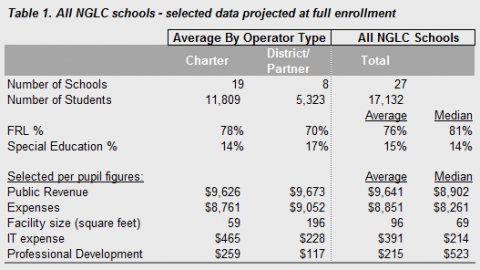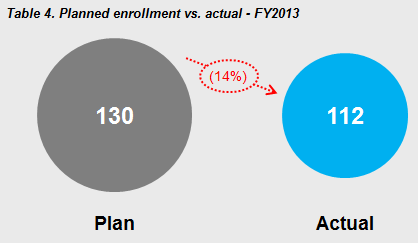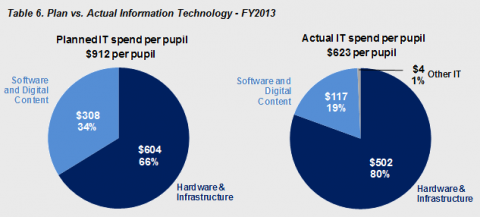New Designs for School
Resource Allocation at NGLC Schools: A Progress Report
Topics

We’ve all had the experience of truly purposeful, authentic learning and know how valuable it is. Educators are taking the best of what we know about learning, student support, effective instruction, and interpersonal skill-building to completely reimagine schools so that students experience that kind of purposeful learning all day, every day.
What do preliminary financial and operational results from a set of innovative, blended learning models tell us about the nature of these pioneering school designs?
“Blended does not solve all things. You still need to run a good school.”
-Tom Willis (Cornerstone Charter Schools)
Last month, before giving a tour of his school during a convening of NGLC-funded schools in Detroit, Tom Willis of Cornerstone Charter Schools said these words to a group of blended learning operators and experts. As we look at some preliminary findings from an analysis of next generation schools, his words certainly hold true, with some caveats that blended learning operators may want to pay particularly close attention to.
But before we look at the outcomes of the analysis, here’s a quick recap of our process and a snapshot of all the NGLC school grantees’ financial plans.
In 2011-2012, Next Generation Learning Challenges (“NGLC”) awarded launch grants to 28 school operators that were seeking to dramatically improve academic results, in part by leveraging blended learning school designs. As part of the application, every prospective school operator submitted a detailed financial plan—the tactical blueprint for operators to realize their academic vision.
These 28 schools comprise our research cohort. 1 Afton looked at the financial plans collectively for all NGLC-funded schools, as well as preliminary results from eight schools that opened their doors in the fall of 2012. A few highlights:
- Members of the cohort present a diverse set of resource allocation strategies.
- It’s clear that blended learning schools plan to use some resources differently than traditional public schools do, including human capital and facilities.
- The experience of schools that opened in 2012 offers valuable lessons for current and future leaders of innovative, next generation public schools.
1. Blended Learning Models: A Diverse Set of Resource Allocation Strategies
NGLC’s RFP articulated seven design principles for applicants. All of the grantees submitted academic, operating, and financial plans that aligned with those seven principles. One was financial sustainability: schools had to plan to operate on recurring public funding within four years of opening their doors. Grantees submitted plans to meet this long-term goal, though some operate in vastly different districts and states and have very different funding models.

At full enrollment, the NGLC cohort includes everything from small schools with fewer than 200 students to larger schools with more than 2,000. One school had a teaching staff of only 7 teachers at full enrollment; another assumed 125 teachers by that time. Projected IT spending also varied widely—from less than $100 per pupil at full enrollment at one school to over $1,000 at another.

Implications
Decisions about spending by different blended learning school operators will doubtless affect both academic and financial performance long-term. But to evaluate schools’ financial performance over time, it’s also important to identify the differences between blended learning models and traditional schools. And while the mean and median for the schools in the cohort are interesting to compare to traditional schools (which we do below), it's also important to consider the significant variances that these school models have from their averages. There is a wide, wide range of experimenting going on in the enrollment and financial models of these breakthrough schools!
2. Comparing Blended Learning School Models to “Traditional” Public Schools
NGLC blended learning schools plan to invest more in information technology and professional development, and less in facilities, than traditional public schools currently operating in their respective states. Blended learning models (at least among this early cohort) also predict a slight decline in spending on human capital.

Implications
NGLC schools must operate within the same funding constraints as traditional schools in their respective states and districts. When commitments are made in one area (such as increased IT spending), schools must make tradeoffs in others. These tradeoffs are inherent in each school's financial planning, and must be evaluated over time. We certainly did not see what many observers have said they hoped to see from blended model schools, however: substantial savings in human resource costs across the board.
3. Implementation Challenges (and Opportunities)
As with any new school, the next generation schools in our cohort faced challenges in the first year of operation. Some trends that emerged from our evaluation of the eight schools that opened in 2012 included:
1) Enrollment came in materially below projections, resulting in a loss of approximately $130K per school. In describing why recruiting students was difficult, school administrators cited both the availability of adequate facilities on a timely basis, as well as parents’ unfamiliarity with new school models.

2) Faced with reduced per-pupil funding, the eight schools reduced their IT and administrative staff spending, while continuing to invest in instructional staff and professional development.

3) While “traditional” IT spending in infrastructure and devices remained relatively close to plan (though still a 17% reduction), schools spent more than 60% less than they had planned on software and digital content.

Lessons Learned
New school startups in this space would be wise to consider increasing investment in communications and recruiting. Though the small sample of schools that opened in 2012 faced initial recruiting challenges, most of those school operators still do anticipate reaching their long-term recruitment goals. When facing resource constraints, schools continued to invest in teachers and teacher support—a reflection, perhaps, of understanding that with all of these schools’ integration technology at the core of their model, the human side of things remains of paramount importance, especially in the early going. We will need to evaluate actual resource allocation over the five-year period, as investing in human capital is projected to be pared back based on existing five-year plans.
Market fragmentation may benefit school IT spending, at least for now, even while it makes actual school launch more difficult. The lack of commonly adopted software, including learning management systems and digital content, makes implementation of blended learning an iterative and challenging process. The silver lining is a reduced upfront cost, among these pioneers, and opportunity for lower-cost (or even free) digital content for students in the absence of better (and perhaps more expensive) options.
Conclusions and Next Steps
No matter how breakthrough any one blended learning model is, it is just one model. And with a sample of only eight operating schools in this review’s first year, we can’t draw any absolute conclusions at this time. But trends and signposts are valuable, and can help steer new investments and new schools. That’s why Afton is partnering with the Center on Reinventing Public Education (CRPE) to perform a long-term resource allocation study of all NGLC schools (the 28 that have been awarded grants to date, and additional schools added in new grant cycles over time). Other work being led by RAND Corporation is examining the schools’ academic models. We believe that a comprehensive study of a statistically significant group of blended learning schools, coupled with analysis of their respective academic strategies and outcomes, will help policymakers, school designers, and district leaders understand not just the true costs of these breakthrough models, especially compared with traditional schools, but also about their true benefits.




